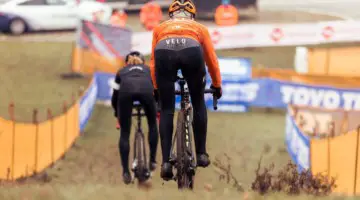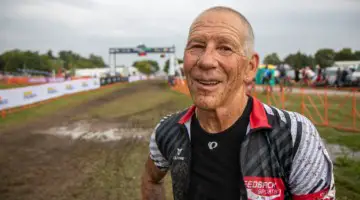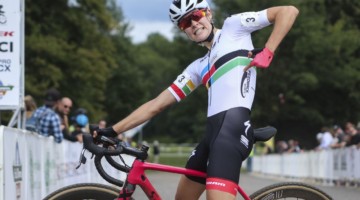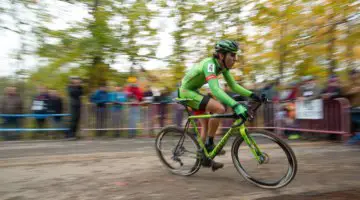“If you can’t stand the heat, get out of the kitchen.” -Harry S. Truman
With cyclocross season starting earlier in the summer these years, we’ve seen some oppressively hot cyclocross races so far this season. Curiously, CrossVegas was not one of them, but the Saturday C1 in Rochester and the World Cup in Iowa City’s Jingle Cross were two notable days that taxed the racers. 2016 World Champ and Jingle Cross World Cup winner Wout van Aert described the Iowa City race as having the “worst-ever heat.” Sanne Cant thought the heat impacted the overseas racers the most, telling Cyclocross Magazine, “We don’t have this weather in Europe. I think that’s the reason there were less Europeans in the top ten.”
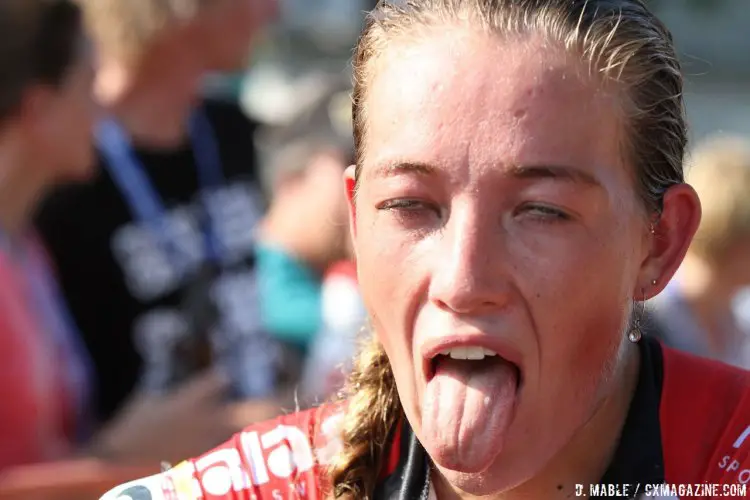
CrossVegas winner Sophie de Boer shows how she feels after a hot, humid day of racing. 2016 Jingle Cross World Cup, Elite Women. © D. Mable / Cyclocross Magazine
Some southern parts of the country will see such hot, and possibly humid conditions for much of the season, while other areas may still face a few more warm weekends. Thus it’s great that we have a timely piece from coach Chris Mayhew that helps cyclocross racers plan for, offset and recover from racing in hot conditions. (Our only regret is that we didn’t publish this piece in time for the Europeans visiting for Jingle Cross.)
Grab a cold one (water bottle) and sit back and take notes.
by Chris Mayhew
I normally try to write these articles six to eight weeks in advance so you can incorporate the advice into your routine before you actually need to implement said advice. However, this column is being written after some lessons learned and observations from the last few weekends of warm racing. To this old dog, the season starts in October. But the reality is that it starts Labor Day now, if not before. And that means dealing with the heat in a way we’ve not had to so much in the past. My pet theory is that ‘crossers self-select for ’cross in part because we don’t deal with the heat well. I personally lose about 1.5 watts off my FTP (Functional Threshold Power) for every degree above 70°F. That said, there are things that can be done to mitigate the issue and I think it’s going to be important for the next couple of weeks (or next couple months if you live in warmer climates) and certainly next season.
Hydrate and Rehydrate
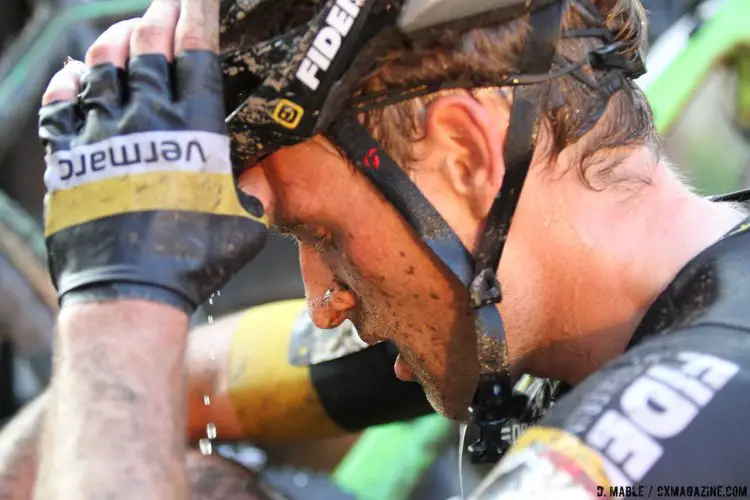
All faced the same heat and humidity in Iowa City, but the Europeans suffered more than most. 2016 Jingle Cross World Cup, Elite Men. © D. Mable / Cyclocross Magazine
I’m going to skip how to adapt to the heat. Presumably by September you’ve been riding in the heat for a while now. But what is your body doing to cope with the heat? The first is sweating, early and often. You can lose up to four liters per hour sweating, which is a lot. That sweat carries off the heat as it evaporates, leaving you cooler. Sweat mainly comes from your circulatory system, and later from the space between your cells. The second thing your body does is the same thing your car does to keep cool. A central pump (your heart) takes heated liquid (blood) from the engine (core) to the surface to allow that fluid to cool, after which it’s returned to the engine. These two mechanisms are why your heart rate is pegged during a hot race. Your heart is working with progressively less and less fluid to circulate as you dehydrate, and pumps faster and faster to move it around and maintain blood pressure. It’s also part of why your performance falls off, there’s less oxygen going to working muscles as blood pools below the skin. Your engine that needs six liters to cool itself effectively might be working with only four or five by the end of the race.
So, what to do about this state of affairs? The biggest and simplest thing you can do is stay hydrated. Even working at a desk indoors in air conditioning, you’re losing some water to the cool dry air via respiration. Keep a bottle handy at work. And monitor the color of your urine. You can use this chart. Focus on staying hydrated during your workout. I find I need two large bottles per hour every hour in warm weather. That requires some planning and logistics on my part, but it enables my training, so make the investment. But even then it’s hard to keep up with what you need. So focus on drinking after your workout as well. Get a bottle down when you walk in the door. I’ve joked that 95% of my onsite coaching this time of year is asking “when’s the last time you peed?” But really, it’s that simple. The sooner (and clearer) the better off you’re going to be.
Another part of staying hydrated is sodium levels. Your body exists in equilibrium on many fronts. You need sodium to store water. So if you drink only water all day, while sweating out sodium, you’re ultimately reducing the amount of water you can store on board and your body will eliminate that “excess” water as clear urine, even if you are dehydrated, because it doesn’t have enough sodium to retain it. At work you don’t need to drink sodium. During your ride I would encourage it. There are many products out there, or you can make your own at home. Find what tastes good to you, you can afford and works well with your stomach. And pay attention to the sodium content, since that varies between products. In general I prefer Skratch drink mix. Osmo works just as well too, if you can find it. In very hot weather I use Sword (my second favorite thing from Kentucky to drink) but some people have trouble with the amount of sodium in it. John Verheul has also pointed out sodium consumption may be more of an issue for vegans and vegetarians because their food isn’t loaded with sodium the way a lot of processed and prepacked food and meats typically are.
The night before and morning of your race paying attention to the above is very important. If you come into race day with even a small debt it’s only going to get worse as the day goes on. Get hydrated, stay hydrated. Maybe you need a bit more sodium on a hot day via your drink mix, or just some soy sauce on your rice and eggs. Once you get on course stay on top of your hydration as you pre-ride and hang around before your race. Either wear a jersey with pockets so you can always keep a bottle with you, or run a cage and bottle on the seat tube of your bike (a cage on the downtube will impair your ability to shoulder your bike). You are exercising even if you aren’t racing yet! Keep track of your urine output and color during the morning too.
Pro tip: don’t pee with your sunglasses on so you can get an accurate reading. -Mayhew
Keep Your Cool
What else can you do, now that you’ve turned yourself into Aquaman? Work on staying cool. Park in the shade if at all possible. Parking on grass is cooler than parking on pavement. Shaded grass is even better. Pop up tents are nice too, if you have room. I’ve shared my opinion on trainer warm ups previously. You’ll probably need less warm up too. Your muscles are already quite warm. Do enough that you’re familiar with the course but not so much you’re overheated. This is also where warm-up clothes are nice to have, because you can go to the line in dry clothes that will wick faster and better than the nasty, sweaty chamois you warmed up in.
The next thing you can do is bring ice with you in some form. A common way is to fill panty hose or an arm warmer with as much ice as you can and pin it to the inside your skinsuit. The ice helps keep your core cool and the resulting ice melt does as well. My friend Chris Cleeland also introduced me to a neat trick if you have pockets. Take two baggies, fill them with ice and snip a little bit off the bottom corner. Place those bags in your pockets to achieve the same result as the ice sock but without the pinning. You’ll want to do this in the 30 minutes before you go to the line so the ice will work during your race.
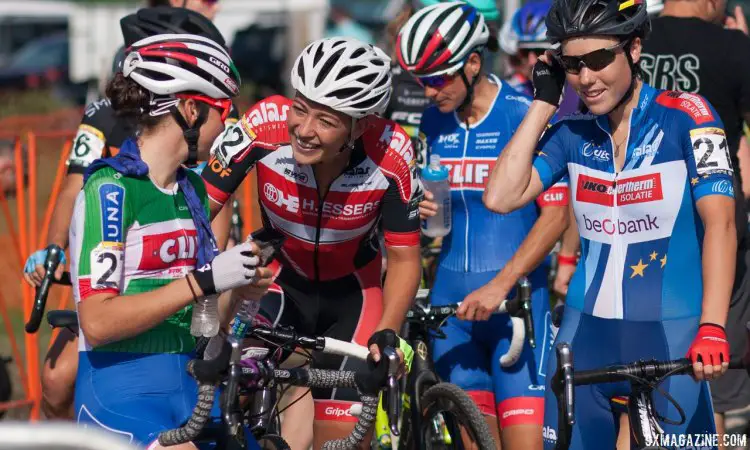
Look closely. Eva Lechner is cooling her neck and has a bottle in her hand, while Sophie de Boer and Katerina Nash both have bottles before the warm 2016 Jingle Cross World Cup starts. © A. Yee / Cyclocross Magazine
During your race hold back on your effort a bit. It’s much easier to start way too hard in the heat and pay a big price later. People at the Rochester UCI races were losing 5-10 spots in a single lap once they overheated. Stay calm and play the waiting game as much as you can. I find gloves are handy just to keep your hands from slipping off the bars. I use the thinnest ones I can, as otherwise I dislike wearing gloves. Mount a cage on your seat tube to carry a bottle. Putting one your back pocket is asking for an irritating experience. It bounces around (and perhaps out) and is very hard to get back in. I know one company makes a bottle specifically for this application but to my mind having a specific bottle like that is one more thing to forget.
Drinking during a race can help stave off dehydration but you can’t drink enough during a race to make up for a lack of prior preparation. Also, know the rules. We found out in Rochester how arduous getting a bottle during the UCI Elite race was in contrast to years before. If part of your plan is to get a bottle mid race, ask an official what the rules are before the race. I’ve had officials interpret rules in ways you would not have expected, so know what the officials have in mind, even if you read the rule book beforehand.
Also, know the signs of dehydration. The biggest and easiest ones are cessation of sweating (e.g. – the reservoir is empty) and goose pimples on a hot day (which may also be accompanied by feeling cold). Those are big signs. If you were an athlete I coach I’d encourage you to drop out at that point, unless you were within shouting distance of the finish. It’s a bike race and it’s not, in my mind, worth ending up in an ambulance over. Make your own decision, but at least know the warning signs. Anything more than that (dizziness, nausea) and you’re in even more serious trouble, and likely in need of medical attention.
Post-race Plan and Preparation
Post-race, what should you be doing? Get cooled down and get hydrated. Rochester had a great system in place (for the Elite men, but not for the Elite women) that I’d encourage any early season race to implement. They had volunteers at the finish line handing cold bottles of water to racers as they crossed the line. They also had garden sprayers they hosed every rider down with. Lastly, they had coolers full of ice in baggies they were distributing.
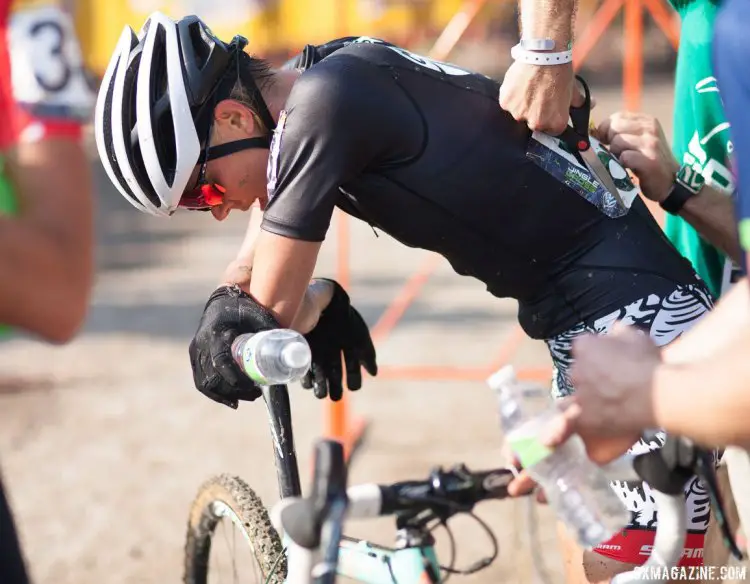
The 2016 Jingle Cross World Cup promoters had bottles ready at the finish, and Emily Kachorek was sure to grab one after the humidity and heat on Saturday. Elite Women. © A. Yee / Cyclocross Magazine
Get water in you to aid sweating and to normalize blood plasma volume. Water in you is better than water on you, but if you can do both that’s great.
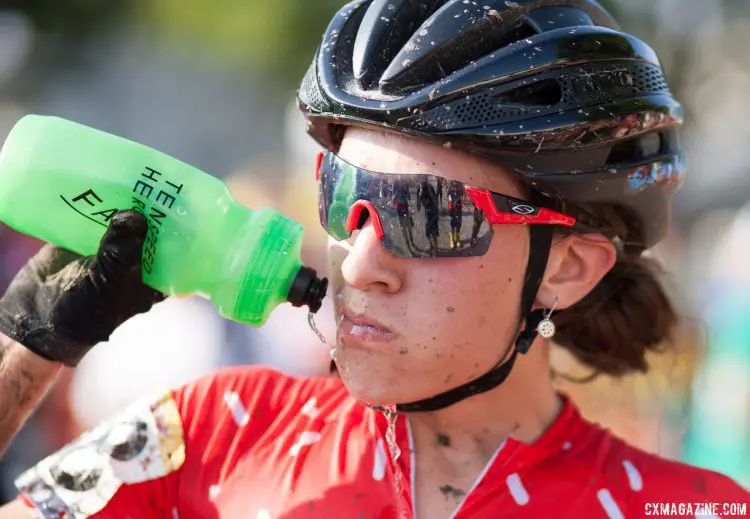
Sofia Gomez Villafane doing her best to hydrate and get some water inside, but some spilled on her jersey helps her cool down after the 2016 Jingle Cross World Cup. © A. Yee / Cyclocross Magazine
If you can get bagged ice on your body post race that’s great too. Under the armpits and in your chamois are the best places. You’ve got a lot of blood vessels there with little to no fat covering them, aiding cooling. Jeremy Powers must have had close to 5 lbs of ice on his back within minutes of the finish.
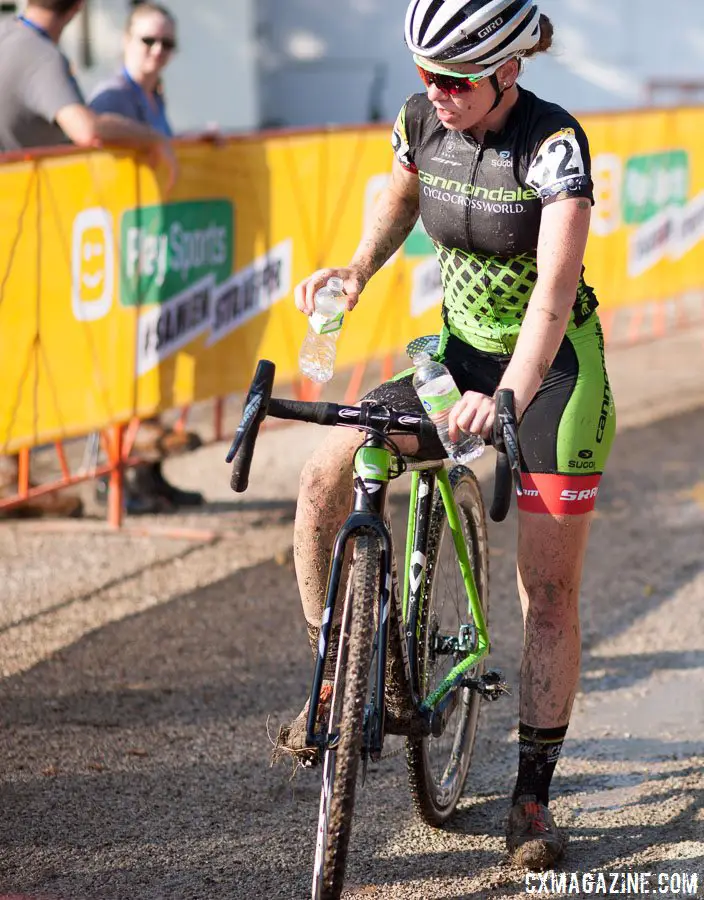
Ruby West may be only 17, but she’s wise beyond her years to grab two botles after the 2016 Jingle Cross World Cup. © A. Yee / Cyclocross Magazine
Once you’re back at the car get on clean dry clothes (again, aid evaporation by getting soaking wet clothes off). Your next focus is hydration. Skip the recovery drinks for now unless it’s a pretty watery mix. You need water to process carbohydrates through the digestive system, so you’re only going to ball up your stomach pushing carbohydrates down while not having enough water in you to actually process them. Water is also needed to avoid what some call ‘cross gut. Mild dehydration, along with some stomach irritation from bouncing, is usually the cause of ‘cross gut. If you’ve ever finished a race and had mild stomach soreness or cramping, start drinking water. Sprite or ginger ale works as well but the main issue is dehydration not allowing food to process, so water is your best option.
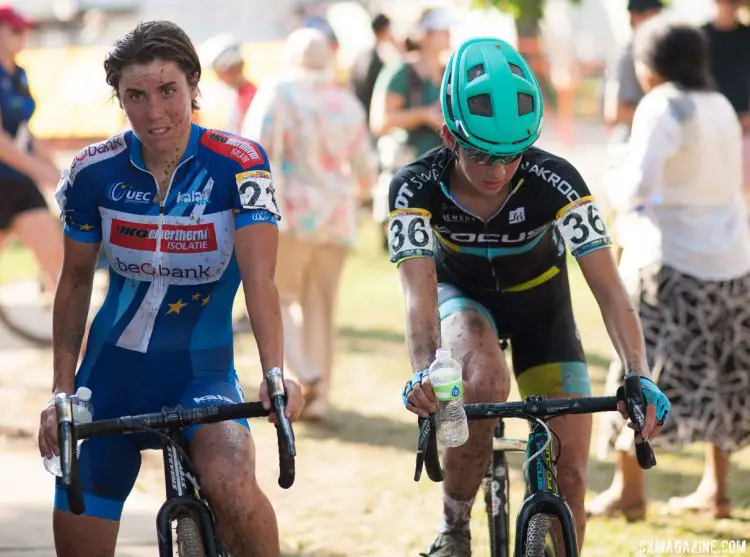
Sanne Cant and Sidney McGill attempt to quickly rehydrate after the 2016 Jingle Cross World Cup. © A. Yee / Cyclocross Magazine
The goal is to pee, and pee clear, as soon as possible. Hopefully within an hour or two post-race. Keep drinking until you achieve that. Here’s something to put a hot race’s effect and rehydration needs into perspective:
Perspective of the heat at #rochestercx yesterday, I drank the equivalent of 8-10 bottles post race and didn't pee until 10:30pm. ?
— Arley Kemmerer (@arleykemm) September 11, 2016
If you have a long drive post-race I’d encourage you to wear compression socks as well. Dehydration can contribute to blood clots, especially when paired with sitting for long periods of time and/or hormonal birth control use. For many people, a big weekend of racing often means a four or five hour drive post-race. And I’ve had two female friends suffer from blood clots likely due to birth control pills, so the issue is always on my mind.
Dealing with the Heat
It’s the new reality of racing ’cross as the season moves earlier in the year. It’s something that demands prior preparation to prevent poor performance. And I think it’s something ’crossers in particular are bad at dealing with as a group, otherwise we’d all be off winning the Tour de France instead. Get a plan to address it, find what works best for you, stay on top of it, and stay cool.
Have your best cyclocross season ever with all of our Training Tuesday pieces here from coaches Mayhew, Adam Myerson and Kenneth Lundgren and others. Can’t get enough? See our Cyclocross Academy and Cyclocross 101 articles here.




























